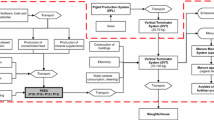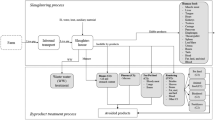Abstract
In order to evaluate the environmental performance generated by a “semi-technified” pig farm, as well as the comparison of different pig production scenarios, pig feed and animal production subsystems were evaluated considering both: (a) origin of feed ingredients and (b) variations in pig weight. Life cycle assessment methodology was used to evaluate the environmental performance, establishing 1 market pig as the functional unit (FU). Three ingredient origin distances (400, 950, and 1800 km) and three slaughter weights (110, 100, and 90 kg) were considered for the simulation analysis and comparison. The feed production subsystem was the main generator of environmental impacts, mainly caused by the cultivation of sorghum and the production of fat. The origin of the inputs represented the main increase in environmental impact for the feed production subsystem, mainly in the Fossil Depletion category, with a fivefold increase by acquiring inputs from 900 km and a ninefold increase at a distance of 1800 km. Producing lighter pigs resulted in the best environmental alternative, given the resultant 11% reduction in environmental impact.





source distance

Similar content being viewed by others
Data availability
The datasets generated and analyzed during the current study are not publicly available because they are property of a commercial farm but are available from the corresponding author on reasonable request.
References
ADEME. (2016). French Environment and Energy Management Agency, Agribalyse program V1.3.
Alba, Y., Barrera, E., Sarduy, A. Pérez, M., Hermida, O., Dewlf, J., 2019. Life cycle assessment for Cuban pig production: case study in Sancti Spiritus. Journal of Cleaner Production. 219, 99-109.
Anestis, V., Papanastasiou, D., Bartzanas, T., Giannenas, I., Skoufos, I., Kittas, C, 2020. Effect of a dietary modification for fattening pigs on the environmental performance of commercial pig production in Greece. Sustainable Production and Consumption. 22, 162-176.
ASERCA Apoyos y Servicios a la Comercialización Agropecuaria. 1996. Una visión de la porcicultura en México. Claridades Agropecuarias. 34. 40 p
Bava, L., Zucali, M., Sandricci, A., Tamburini, A, 2017. Environmental impact of the typical heavy pig production in Italy. Journal of Cleaner Production. 140, 685-691.
Basset-Mens, C., van der Werf, H, 2005. Scenario-based environmental assessment of farming systems: the case of pig production in France. Agriculture, Ecosystems and Environment. 105, 127-144.
Boulanger, A. 2011. El control de agua y su consumo en porcinos. Sitio Argentino de Producción Animal: http://www.produccionanimal.com.ar/agua_bebida/control_agua_y_consumo.pdf. Accessed 20 Jan 2021.
Domínguez, G., Galindo, A., Salazar, G., Barrera, G., & Sanchez, F. (2014). Las excretas porcinas como materia prima para procesos de reciclaje utilizados en actividades agropecuarias. Jalisco: SAGARPA-INIFAP.
FAOSTAT. 2020. https://www.fao.org/faostat/es/#home. Accessed 20 Jan 2021.
Gerber, P., Steinfeld, H., Henderson, B., Mottet, A., Opio, C., Dijkman, J., Falcucci, A., Tempio, G, 2013. Tackling climate change through livestock – A global assessment of emissions and mitigation opportunities. Food and Agriculture Organization of the United Nations (FAO), Rome.
González, S., Belo, S., Dias, AC., Várzea, J., da Costa, R., Ferreira, A., Arroja, L, 2015. Life cycle assessment of pigmeat production: Portuguese case study and proposal of improvement options. Journal of Cleaner Production. 100, 126-139.
Huerta, O., 2013. Productividad y visión de negocio de las empresas porcinas, en Bobadilla, E., Martínez, F, E., (Eds.), Porcicultura Mexicana: Auge y crisis de un sector. Universidad Autónoma del Estado de México, Mexico, pp. 165–172.
ISO, 2006a. Environmental management-life cycle assessment-principles and framework.
ISO, 2006b. Environmental Management-Life Cycle Assessment-Requirements and Guidelines.
Lamnatou, C., Ezcurra, X., Chemisana, D., Plà, L, 2016. Environmental assessment of a pork-production system in North-East of Spain focusing on life-cycle swine nutrition. Journal of Cleaner Production. 137, 105-115.
Méndez, R., Castillo, E., Vázquez, E., Briceño, O., Coronado, V., Pat, R., & Garrido, P. 2009. Estimación del potencial contaminante de las granjas porcinas y avícolas del estado de Yucatán. Ingeniería. 13(2), 13-21.
McAuliffe, G., Chapman, D., Sage, C, 2016. A thematic review of life cycle assessment (LCA) applied to pig production. Environmental Impact Assessment Review. 56, 12-22.
McAuliffe, G., McAuliffe, Takahashi, T., Mogensen, L., Hermansen, J., Sage, C., Chapman, D., Lee, M., 2017. Environmental trade-offs of pig production systems under varied operational efficiencies. Journal of Cleaner Production. 165, 1163-1173.
Ministerio de Agricultura, Pesca y Alimentación. (2004). Cuadros de cálculo de emisiones del sector ganadero en relación con la directiva IPCC. Spain, Government of Spain.
Nguyen, T., Hermansen, J., Mogensen, L, 2011. Enviromental assessment of Danish pork. Aarhus University, Department of Agroecology, Denmark.
Noya, I., Villanueva, P., González, S., Fernández, M., Rodríguez, M., Moreira, M, 2017. Life Cycle Assessment of pig production: A case study in Galicia. Journal of Cleaner Production. 142, 4327- 4338.
OCDE. 2019. Exámenes de mercado en México. Estudio de Mercado de la carne de cerdo. https://www.oecd.org/daf/competition/examenes-de-mercado-en-mexico-estudio-de-caso-del478mercado-de-la-carne-de-cerdo.htm (consulted on May 3, 2020).
Olea, R. 2009. Analysis of Sustainability in the Pig Production Chain: Life Cycle Assessment of Contrasting Scenarios. Newcastle University (PhD).
Open LCA. (18 de 02 de 2019). The open source Life Cycle and Sustainability Assessment software. Obtenido de https://www.openlca.org/release-openlca-1-8/. Accessed 20 Jan 2021.
Pérez, R. 2001. Porcicultura y contaminación del agua en la Piedad, Michoacán, México. Revista Internacional de Contaminación Ambiental. 17(1), 5-13.
Rebollar, S., Gómez, G., Hernández, J., Rojo, R., de Jesús, F., Avilés, F. 2007. Determinación del óptimo técnico y económico en una granja porcícola de Temascaltepec, Estado de México. Ciencia Ergo Sum. 14 (3), 255-262.
Rebollar, S., Gómez, G., Callejas, N., Guzmán, E., Hernández, J. 2014. Óptimos técnicos y económicos en cortes de carne de cerdo en dos regiones de México. Agronomía Mesoamericana 25 (1), 161-168.
Reckmann, K., Traulsen, I., Krieter, J., 2012. Environmental Impact Assessment - methodology with special emphasis on European pork production. J. Environ. Manag. 107, 102 - 109.
Reckmann, K., Traulsen, I., Krieter, J., 2013. Life Cycle Assessment of pork production: A data inventory for the case of Germany. Livestock Science. 157, 586-596.
Rodríguez, G., Díaz, M., 2013. Situación de la porcicultura porcina en México, en Bobadilla, E., Martínez, F. E. (Eds.), Porcicultura mexicana: auge y crisis de un sector. Universidad Autónoma del Estado de México, Mexico, pp. 53–81.
SAGARPA Secretaria de Agricultura, Ganadería, Desarrollo Rural, Pesca y Alimentación. 1998. Situación actual y perspectivas de la producción de carne de porcino en México 1990-1998. México. 73 p.
SIAP. 2013. Regiones Agroalimentarias de México. https://www.gob.mx/siap/prensa/presenta-la-sagarpa496 serie-monografica-regional-agroalimentaria-38627 (consulted on May 3rd, 2020).
SIAP. 2018. Producción agrícola. Avances de siembras y cosechas, resumen nacional por estado. https://www.gob.mx/siap/acciones-y-programas/produccion-agricola-33119 (consulted on May 3rd, 2020).
SNIIM. 2020. Mercados Nacionales Pecuarios, Porcinos. http://www.economiasniim.gob.mx/nuevo/Home.aspx?opcion=/SNIIM-Pecuarios-Nacionales/MenPec.asp?var=Por (consulted on August 20th, 2020).
Soleimani, T., Gilbert, H. 2021. An approach to achieve overall farm feed efficiency in pig production: environmental evaluation through individual life cycle assessment. The International Journal of Life Cycle Assessment. 26, 445-469.
Srnicek, N., Williams, A. 2017. Inventar el Futuro. Poscapitalismo y un Mundo sin Trabajo. Malpaso Ediciones. Barcelona.
Wang, X., Dadouma, A., Chen, Y., Sui, P., Gao, W., Jia, L, 2015. Sustainability evaluation of the large-scale pig farming system in North China: an energy analysis based on life cycle assessment. Journal of Cleaner Production. 103, 144-164. https://doi.org/10.1016/j.jclepro.2015.04.071
Acknowledgements
The authors wish to thank the National Council for Science and Technology of Mexico for scholarship number 570063, granted to María del Rosario Villavicencio Gutiérrez for the purpose of carrying out her doctoral studies; the pork producer that kindly provided the information used in this study; and the UAEM 4219/2016SF research project.
Funding
This work was supported by the National Council for Science and Technology (Spanish abbreviation: CONACYT) with scholarship number 570063, granted to María del Rosario Villavicencio Gutiérrez for the purpose of carrying out her doctoral studies and The Autonomous University of the State of Mexico research project UAEM 4219/2016SF.
Author information
Authors and Affiliations
Contributions
María del Rosario Villavicencio-Gutiérrez: investigation, formal analysis, writing — original draft, software; Nathaniel Alec Rogers-Montoya: writing — review and editing; Angel Roberto Martínez-Campos: validation; Germán Gómez-Tenorio: resources; Francisco Ernesto Martínez-Castañeda: data curation, conceptualization, methodology, supervision.
Corresponding author
Ethics declarations
Ethics approval
Not applicable.
Consent to participate
Not applicable.
Consent to publish
Not applicable.
Competing interests
The authors declare no competing interests.
Additional information
Publisher's note
Springer Nature remains neutral with regard to jurisdictional claims in published maps and institutional affiliations.
Rights and permissions
About this article
Cite this article
Villavicencio-Gutiérrez, M.R., Rogers-Montoya, N.A., Martínez-Campos, R. et al. The environmental performance of different pork production scenarios: a life cycle assessment study. Trop Anim Health Prod 54, 44 (2022). https://doi.org/10.1007/s11250-022-03045-6
Received:
Accepted:
Published:
DOI: https://doi.org/10.1007/s11250-022-03045-6




